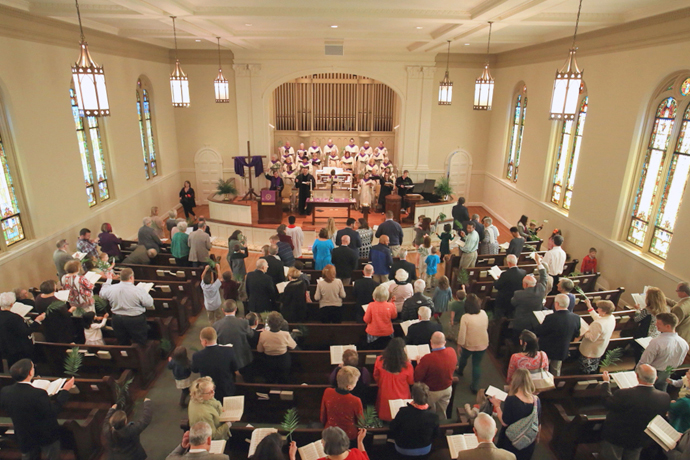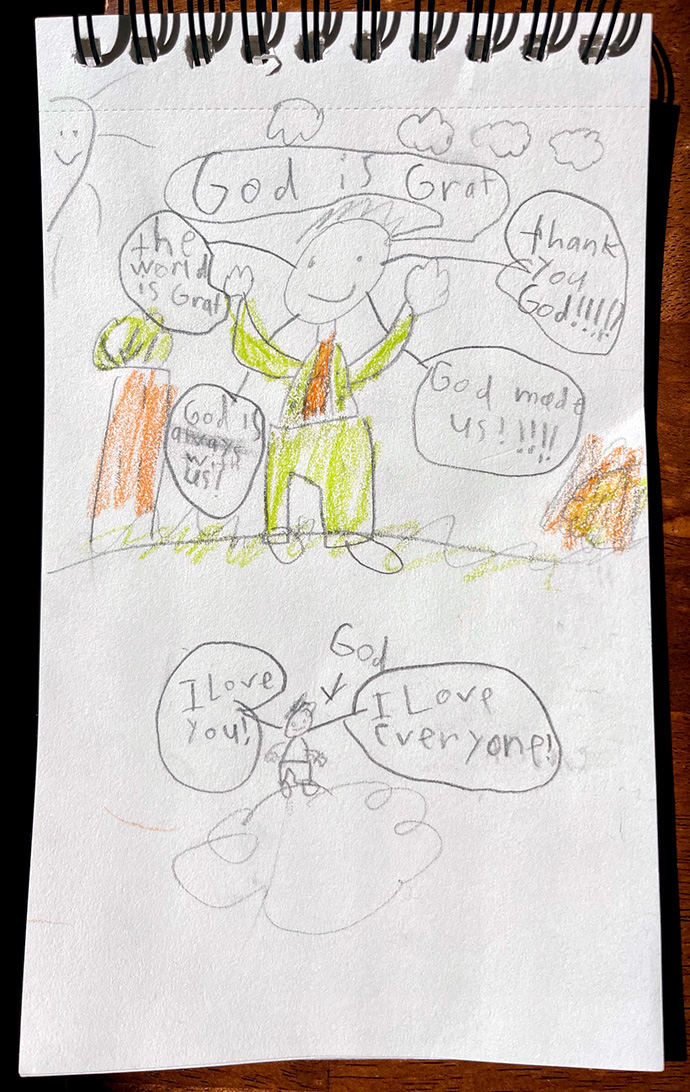
Key points:
- Lighthouse Congregations declare themselves to be solidly United Methodist and provide a safe, supportive place for people who mean to stay in the denomination after their local church has voted to disaffiliate.
- The North Carolina and Western North Carolina conferences have embraced the concept and seen dozens of congregations become Lighthouse Congregations.
- Other conferences are developing similar efforts.
Morganton, North Carolina, is in the Blue Ridge Mountains, about a four-hour drive from the Atlantic Ocean. It’s not exactly lighthouse country.
But the First United Methodist Church of Morganton is a Lighthouse Congregation, and so proud to be one that it just hung a big outdoor banner announcing the fact.
“Through this, our congregation has some very important things to offer in the life of The (United Methodist) Church,” said the Rev. Dana McKim, senior pastor. “We can be a sign of hope.”
Lighthouse Congregations declare themselves to be solidly United Methodist — and a safe, supportive place for people who mean to stay in the denomination after their local church has voted to leave.
The North Carolina and Western North Carolina conferences have been the incubator for the idea, and it’s taken hold in both. The North Carolina Conference, hard hit by disaffiliations, has had 72 churches become Lighthouse Congregations in recent months. The Western North Carolina Conference has 46, with others exploring becoming one.
Other conferences — including Arkansas, Indiana, Western Pennsylvania and Kentucky — are beginning similar programs and using lighthouse imagery or a close variation.
McKim says First United Methodist in Morganton is well along in living up to its lighthouse designation, finding various ways to help United Methodists who are feeling a bit lost.
He tells of a woman who once belonged to the Morganton church but relocated two hours away and was on the losing end of her new church’s vote to disaffiliate. She recently called McKim and asked if she could move her membership back to First United Methodist in Morganton.
“When I said, ‘Welcome home,’ the woman broke down into tears,’” McKim said.

The Lighthouse Congregations idea emerged as conferences began to consider how to minister to people whose churches were leaving under Paragraph 2553 of the United Methodist Book of Discipline.
That provision, approved by the 2019 General Conference, recognizes The United Methodist Church’s longstanding internal dispute over LGBTQ inclusion. It lets U.S. churches exit the denomination with their property, provided they have at least a two-thirds congregational vote in favor of disaffiliation, obtain their annual conference’s approval and meet certain financial requirements.
By UM News’ tally, 2,095 churches have so far received annual conference approval for departure under Paragraph 2533. Others are lined up to go, and there will be special, disaffiliation-focused annual conference sessions through the end of 2023, when the provision expires.
When the pace of disaffiliations quickened last year, conferences recognized that there would be many people in exiting congregations who want to stay United Methodist, and who might be needing guidance and pastoral care.
The Rev. Steve Harper, a retired pastor helping with the Florida Conference’s post-disaffiliation response, had the idea of finding churches that were strongly United Methodist and would agree to be a resource and place of refuge. He had a metaphor in mind, too.
“I thought, ‘Well, we could create some lighthouse churches in each district to keep people from crashing and not knowing what to do,’” he said. “My wife has a beautiful picture of a lighthouse in one of our rooms, and that might have had something to do with it.”
There’s been a lot of annual conference cooperation in the wake of disaffiliations, and the Western North Carolina and North Carolina conferences ran with Harper’s concept, formalizing it into Lighthouse Congregations.
They also came up with a nifty logo, knowing that for symbolism, it’s hard to beat a lighthouse.
“That’s a good name. Just the word itself refers to the light of Christ and that we are to be a beacon of love for all people,” said the Rev. Lynda Ferguson, who leads the First United Methodist Church of Asheboro, a Lighthouse Congregation in the Western North Carolina Conference.

Churches seeking to become Lighthouse Congregations must be strongly committed to United Methodism, with no prospect for disaffiliating.
That’s important for many of the new people they’re serving, including Tracy Agnew. She began to attend First United Methodist Church of Graham, North Carolina, after her church voted to leave the denomination.
“It was very reassuring to me when First United Methodist decided they wanted to be a Lighthouse church,” Agnew said. “I don’t want to have to go through the (disaffiliation) process again. That was one of the most difficult things I’ve ever done. It was very hard to leave the people who had become my family.”
But Agnew is committed to United Methodism, and at First United Methodist in Graham she’s among people who feel the same.
“I have made the decision I want to join First United Methodist,” she said. “Plans are underway to do that on Easter Sunday, actually.”
Lighthouse Congregations in the Western North Carolina Conference have four key responsibilities, said the Rev. Rob Hutchinson, who is overseeing the effort there.
- They must provide a safe space and hospitality for people arriving from disaffiliating churches.
- They must offer them opportunities for worship and mission.
- They agree to help organize remnant groups of United Methodists looking for a place to worship.
- They commit to staying in touch with their conference and district to access whatever new resources are coming out to support those wanting to stay United Methodist.
Support for pastors of exiting churches
Many in The United Methodist Church have expressed concern about those who want to remain in the denomination but are part of a local church that has voted to disaffiliate.
The Rev. Laura Auten has had those people on her heart, but also another group: pastors who are fully committed to The United Methodist Church but who are serving a church that’s decided to leave.
Auten, superintendent of the Western North Carolina Conference’s Uhwarrie District, has formed a support group called Table in the Wilderness to help such pastors, as well as those whose churches haven’t yet voted to leave but have had intense discussion about doing so.
“It’s a place to vent, and it’s a place to get information,” Auten said. “I think it’s some of the most important work I’ve done this year.”
Group members include the Rev. David Talbert, pastor of Salem United Methodist Church in Albemarle, North Carolina. The church voted in January to disaffiliate, an action that will be up for approval by the North Carolina Conference during a May 6 special session.
Talbert credits the support group with helping him cope with an outcome he didn’t want — and with the uncertainty about what his next appointment will be, once he completes a leave of absence that begins this month.
“One of the great modern theologians is Bob Dylan,” Talbert said with a chuckle. “He has a song from (the album) ‘Blood on the Tracks’ called ‘Shelter From the Storm.’ That’s been my metaphor for Table in the Wilderness. It’s been my shelter from the storm.”
At First United Methodist Church of Graham, the Rev. Claire Clyburn has tackled the safe space and hospitality mandate by creating a special small group for people who want to remain United Methodist after their church voted to disaffiliate.
The group, which Clyburn titled “Exiles and Other Wanderers,” began to meet on the first Sunday of Lent, Feb. 26, and drew 18 people.
“It’s just a good way to treat wounded people,” Clyburn said of her effort. “It arose out of a pastoral care response.”
Another Lighthouse Congregation, Bethany United Methodist in Albemarle, North Carolina, has been providing meeting space for a group of about 40 United Methodists who wanted to worship together after their church disaffiliated.
“Our congregation supports the remnant group through our hospitality, prayers and use of our facilities,” said the Rev. David Cochran, pastor. “Bethany is committed to allowing those in the remnant group to discern at their own pace and discover which steps they will take as the Holy Spirit leads them.”
As the Lighthouse Congregations idea has spread in the North Carolina and Western Carolina conferences, individual churches have moved quickly to get on board.
The Rev. Ed McKinney heard about Lighthouse Congregations on a Tuesday and by Thursday his leadership team at Stokesdale United Methodist had voted to sign up.
“They were unanimous in deciding that this was where we needed to go,” McKinney said, adding that the effort is a natural extension of the church’s stated commitment of “reflecting God’s love at the heart of the community.”
Hutchinson has heard from a range of Lighthouse Congregation pastors that the program is a boon to participating churches as well as to the individuals and families coming to them for care.
“For churches that want to remain with The United Methodist Church, it’s been an energizing experience,” he said. “Churches are excited to have a tangible part of what’s next.”
Hutchinson stresses that churches don’t sign up to be a Lighthouse Congregation as a church growth strategy. It’s all about caring for displaced United Methodists.
But they are indeed seeing new faces, and that’s been cheering after the pandemic severely disrupted attendance. One small church in the North Carolina Conference, Ware’s Chapel United Methodist, has received more than 30 new members from disaffiliated churches.
More important, pastors insist, is that Lighthouse Congregations are a source of light in a season characterized by division and broken connections.
“I suddenly realized, ‘Hey, we’re in a position to bring some hope and healing through this,’” said McKim, the Morganton pastor. “It’s that idea that I’m for something instead of against something that very much resonated with me.”
Hodges is a Dallas-based writer for United Methodist News. Contact him at 615-742-5470 or newsdesk@umcom.org. To read more United Methodist news, subscribe to the free Daily or Weekly Digests.




